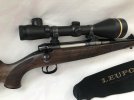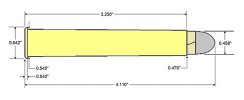The author of the following two newspaper articles is a gunsmith - expert from Poland, Mr. Waldemar Laskowski. (
http://www.dobryrusznikarz.pl/)
Historic express In 1884, over 50 years after its founding, the Viennese gunsmithing factory Joh Springer's Erben created a horizontal express designed for hunting on the Dark Continent. At the turn of the 19th and 20th centuries, safaris became fashionable among the upper classes. Much later, the weapon was also useful on film sets. during the filming of "In Desert and Wilderness" What is so revolutionary about this famous coffee machine? Waldemar Laskowski At the turn of the 19th and 20th centuries, when the British Empire ruled over half of Africa, there was a real boom in hunting for local large game. There were many animals on the Dark Continent, hundreds of thousands of elephants, buffaloes and antelopes. This abundance ensured that hunters always obtained the desired trophy. Safaris became fashionable among the world's aristocracy and hunting in Africa was considered a good thing.For this social class, hunts were organized on a huge scale, with the participation of many people - porters, trackers, skin preparers, etc. Safaris usually lasted from one to three months. Historical chronicles detail such expeditions, which were carefully documented, such as the three-month safari of US President Theodore' a Roosevelt or Ernest Hemingway's hunt (he described them in his book "The Green Hills of Africa", although the Polish translator slightly distorted the information contained in the original version, especially the fragments regarding weapons)
In the 19th century, shotguns in large calibers of 10 or even 8 were mostly used for hunting. It was only with the invention of rifled barrels and smokeless gunpowder that the caliber was limited and the energy of the bullet was increased. At that time, dozens of factories were established that made weapons to order in small quantities, but with extraordinary craftsmanship and precision Many gunsmiths gained great fame and reputation. It was from them that the aristocracy ordered weapons. Also at that time, large calibers were created for hunting African game. A tool was also invented that was particularly useful for hunting dangerous species - quickdraws, i.e. a break-action weapon with two rifled barrels To this day, no one questions its usefulness. Coffee machines are built in various configurations, vertical or horizontal, but connoisseurs prefer the traditional, horizontal arrangement of barrels.As they claim, the horizontal coffee machine is not only characterized by historical beauty, but also has... a soul
brilliant gunsmithing work In Austria, a country of weapons producers, in addition to large arms factories, there are still dozens of small family workshops and gunsmithing workshops. One of them was the Joh factory. Springer's Erben, founded in 1830 in Vienna. It produced weapons of the highest quality. It quickly gained recognition and the most prestigious clients of that period, such as Emperor Franz Joseph, Emperor Wilhelm II, Prince of Monaco, etc. It is as if Albert II of Monaco, Prince of Monaco, called one of the Lublin gunsmiths today and ordered a weapon... This would mean great prestige and fame. scale. Mentioned the company still exists in the same place. In 1955, it ceased production and deals only in the trade of weapons and accessories for hunters. Another shotgun in very good condition, in 12 caliber, made by this manufacturer, came to my workshop. It was well-kept and untouched by pseudo-professional gunsmiths. The mechanisms had in perfect condition, never repaired, but the barrels inside looked as if they had recently left the factory. You have to bow your head to the previous owners for taking such good care of their weapons. In 1884, the Viennese factory, commissioned by Count Bela Szegedy, made a horizontal 450 caliber shotgun. Nitro Express, intended for hunting African game. This caliber was developed by the famous John Rigby company from London with safari in mind. It was chambered in smokeless cordite powder, which at that time provided almost 6,000 joules of energy.After World War II, the express was found in Poland in very good condition, intact inside, one could say that the barrels were shiny inside, as if only a few shots had been fired.
This hammered weapon has two sliding safety catches that block the hammers from falling and accidental firing, which is a solution unique on a global scale. The machine weighs 6.7 kg, thanks to the shift of the center of gravity forward, it is very agile and agile, and the recoil of the barrel end after the shot is really small. The settlement has been shaped in such a way that it suits almost everyone - from a small-built shooter to a 2-meter-tall man. There is also a hand rest made of horn behind the triggers to increase the holding surface during the shot and prevent the weapon from being pulled out of the hand. The machine is equipped with two manually operated rear sights, graduated in yards. Additionally, each trigger has its own accelerator. In addition, the engraved metal foot has a compartment for one piece of ammunition. The baskila and side zippers are engraved and decorated with a fine arabesque. The weapon uses another unique solution. Express rifles with permanently connected barrels have a drawback that in order to hit accurately with two barrels, shots must be fired within an interval of no longer than 10 seconds. Otherwise, the barrel from which the shot was fired expands due to the increase in temperature and pulls the second, cold barrel, which causes an increased distance between the bullet holes between the barrels. However, the designers from Springer's found a very good, cheap and revolutionary solution for those times. After soldering, the barrels were cut through the middle of the sight rail at a length of about 12 cm with a hair-shaped jewelry saw. It looks like this as if for the last 12 cm the barrels were free and independent of each other, but their overall stiffness was preserved. Thanks to this, it was possible to minimize the influence of temperature on the second barrel. When I shot both barrels with this machine more than two minutes apart, I did not notice any increased dispersion.Please note how brilliant the designers were at that time, as the Springer's documentation indicates that the machine was manufactured 133 years ago. A few years ago, Ryszard Skwarek, a gunsmith from Koszalin, made a second set of barrels in the more European caliber 9.3x74 R. They are located on them assembly bases for EAW rotary assembly, on which a running scope is attached.
on the film set In 1971, preparations for the filming of "In Desert and Wilderness" began. So the search for an appropriate weapon began. Thanks to the help of PZŁ, we managed to find an owner in Poland who had the perfect unit for this purpose - an African-caliber 450 NE shotgun. It was lent to the producers. film It can be seen already in the first two minutes and recognized by the characteristic side fuses in the scene in which Staś Tarkowski (played by Tomasz Mędrzak) tries the shotgun, aiming at the set stones, and in subsequent sequences he shoots at the lion. I managed to contact Mr. Tomasz Mędrzak from the TM Theater and thanks to his kindness I obtained some additional important information about the filming of "In Desert and Wilderness".To increase realism, attention was paid to the smallest details, which is why for the needs of the film, the specialist made special blank ammunition, which had to be strong enough for the viewer to see the toss of the weapon after firing the shot and see the characteristic smoke coming out of the barrel. The actor who played the role of Stas Tarkowski provided several more other interesting facts from the film set, especially about the scene in which he shoots at a lion. It was impossible to aim at a live animal, so he dressed up in a lion's skin stuntman. This function was performed by Krzysztof Fus, one of the best stuntmen at that time. After the shot, the lion falls from a 4-meter rock. A certain trick was used in this technically difficult scene. A pyrotechnic micro-charge was attached under the barrel of the espresso machine, with a cable routed through the shirt sleeve and trouser leg to the pyrotechnician responsible for igniting it. The scene is shot from behind, over Staś's shoulder. At the moment of the shot, a charge of magnesia was fired, which was intended to produce an additional cloud of smoke to hide some imperfections when the lion rolled down the rock. As you can see on the screen, everything worked out perfectly.
In my search for material for this article, I found people who still remember the making of the film. During preparations for filming, there was a problem with ammunition for the coffee machine. It turned out that they only had a few pieces, so they had to buy more. There was none in Poland, so the only solution was the purchase remained abroad. The position of Minister of Culture and Art was then held by Lucjan Motyka. He got to know this problem and asked for help from Piotr Jaroszewicz, who had great opportunities at that time. He turned to the diplomatic corps. After some time, someone from one of the diplomatic missions found out that ammunition in 450 NE caliber can be ordered and then transported to West Berlin and picked up there. It was the 1970s, the Cold War was going on. A trip to West Berlin was bordering on a miracle, especially since it involved purchasing ammunition.Piotr Jaroszewicz rose to the challenge and arranged all the necessary permits and documents. According to the information of Ryszard Ochocki's grandson, his grandfather, an outstanding specialist in film pyrotechnic effects, who worked at the Feature Film Studio in Łódź and was an extraordinary weapons expert, went personally to collect the ammunition. He practiced in well-known English companies. gunsmithing and in the Merkel factory He was the one who created the central weapons warehouse for film purposes and was entrusted with making special blank ammunition for "In Desert and Wilderness". As you can see on the screen, he fulfilled this task perfectly famous specimen All other information regarding the described coffee machine comes from direct correspondence with the current co-owner of the company, Joh. Springer's Erben – Margaret Weixelbraun, who had to find documentation from over 100 years ago in the basement. Mrs. Margaret was very apologetic for the two-day delay in responding, as she stated that she had reviewed several dozen kilograms of documents. I shot this gun in a few different rounds. Ultimately, the best results were obtained with ammunition fired with a 31 gi bullet at a speed of 668 m/sec, which after conversion gave energy approx. 7 thousand joules. In my opinion, shooting with the new 9.3x74 R barrels is also satisfying, but not as satisfying as with the 450 NE. Finally, I would like to add that, in my opinion, using this coffee machine is a unique pleasure. Even a solid push on the shoulder makes the experience of shooting such a historic weapon unforgettable. The machine is so famous that many famous people came to me because they wanted to see and hold this famous weapon. Its owner is a famous traveler who has circumnavigated almost the entire globe. l The author would like to thank Mr. Tomasz Mędrzak and Mrs. Margaret Weixelbraun for providing detailed and comprehensive information.







